TRAVEL
GUIDE
|
Puerto
del Carmen Weather
Lanzarote
Towns & Resorts
|
Arrecife
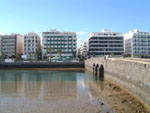
Arrecife
was once just a port - that of Teguise. There were two main fortresses,
San Gabriel and
San José with a third - Castillo de San Gabriel - located on
a small island in front of Arrecife. The third fort was connected to
the main one by a drawbridge. It was from these forts that the
islanders tried (unsucessfully in the end) to defend themselves against
pirate attacks.
A
fourth castle, that of Castillo de San Juan, is home to the city's
Museum of Contemporary Art. One of the museum's main attractions is the
work of Cesar Manrique.
Today,
Arrecife is the island's capital. Of the 90,000 residents on Lanzarote,
half reside in Arrecife. Along the beach-front there's a wide,
palm-lined promenade. The wide, main street through the city is
Léon y Castillo and most of the remaining streets of the
city are narrow and form part of the one-way system.
The
Gran Hotel in Arrecife is the only high-rise building on the island.
Since its construction, laws have been passed preventing any further
high rises and the hotel itself, closed down and currently unused.
Leon
y Castillo is the main shopping street and as you walk along away from
the seafront, head to the right as you come to the end of this street
and enjoy the view over El Charco.
Here's
a strange tip for you; if you're down by the fishing docks when the
fisherman return (bearing in mind they can often be out for up to three
weeks at a time) and have a plastic bag with you, the generous
fisherman are known for giving away samples of their sardine catch.
Barbecued sardines are a local favourate.
|
|
Teguise
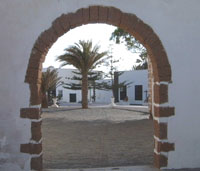
Located
in the center of the island and 220 meters above sea level, Teguise was
once the capital until 1852, and was home to the Guanche King. It's
also one of the oldest settlements in the Canary Islands. The town was
named after the Guanche King's daughter. Little of the origional town
remains, having suffered numerous attacks from pirates.
The
main feature of the town today is the castle, "Castillo de Santa
Barbara", built on the old volcano of Guanapay. One of the more
interesting industries of the town is the making of "Timples" - small
guitars popular with Canarian musicians.
For
the tourist, well worth seeing are the palacial houses of
Spínola's and The Torres, fine examples of the impressive
architecture of the town, along with the Church of Nuestra Senra de
Guadalupe and the two convents of Santo Domingo and San Francisco.
Numerous craft shops and small bazaars offer an abundance of shopping
for traditional souveniers, as does the open-air market held each
Sunday in and around the town's main square. Also on a Sunday, at noon
and after mass, local musicians dressed in traditional costume perform
music and dance.
Just
outside the town well worth a visiti too are the Church of Parroquia
San Miguel and the Museum of Palacio de Spinola.
|
Costa
Teguise

Costa
Teguise is the most recently developed of Lanzarote's three main
holiday resorts and has been created around the area's beautiful sandy
beaches. Prior to the 70s only the beaches occupied this part of the
island, the resort itself being devloped over the last 30 years.
Initially, one Spanish company "Rio Tinto" bought, built and owned the
entire resort but since, the company privatised and the resort sold off
in parts.
The
golden sands of the popular Playa Bastian beach offer the perfect place
to quietly enjoy the sub-tropical sunshine. The "Las Cucharas" beach is
a windsurfer's dream! There's an 18 hole international -standard golf
course only a few minutes drive away and also nearby there's an aqua
park for the kiddies. There's a great selection of bars, shops and
excellent accommodation.
|
|
Puerto
del Carmen
 
Puerto
del Carmen is the main tourist resort on the island. There's the "Old
Town" area with the harbour-side restaurants and the newer and adjacent
purpose-built holiday area with restaurants, shops, and superb
night-life with clubs, discos and a casino. It's a place that caters
for everyone! In the 1970s, the "Old Town" was all that existed here,
the remaining resort being constructed over the last 20 years.
Puerto
del Carmen has over 3km of golden beach. The main road through the
resort runs the whole way along behind the beach.
|
|
Tias
A
large village 5 km north of Puerto del Carmen which is mainly
residential and typically Canarian. There are excellent shops and
restaurants in the friendly community and it is a perfect location for
those looking for a holiday away from the main tourist centres.
|
Playa
Blanca
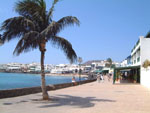
This
is a tranquil town situated in the very south of the island. Named
after the white sandy beaches in the area. Mainly a quiet and unspoilt
resort, it's the quietest, flatest and the warmest of the three main
resorts on the island. The centre of the town has retained much of its
original fishing village charm. There's a good selection of shops and
supermarkets and many excellent restaurants. I should mention that in
my personal opinion, the resort is going to double in size from 2000 to
about 2003 as the resort is extended to the Papagayo beach area to the
eastand Montana Roja to the west. Whilst the center of the resort is
very beautiful and picturesque, the outskirts are effected by building
work.
Playa
Blanca has some superb very shallow beaches which are perfect for small
children. In addition, the Papagayo beaches, which are some of the most
beautiful in the Canaries, are only a few minutes drive away. Ferries
depart at regular hourly intervals each day from the harbour to the
nearby island of Fuerteventura, just 6 miles away and the island can
clearly be seen from most parts of the resort. (If you can see the
mountains in the background of the picture below, that's Fuerteventura
as seen from Playa Blanca).
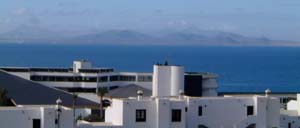
|
|
Haria
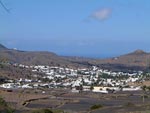
The
best way to approach the village is from Teguise as this road gives you
an impressive view from above as you approach it. Haría is
known as the 'village of the thousand palms'. A beautiful village
indeed and though there are quite a lot but I wonder if anyone's
counted a thousand of them?. ... and why so many? Tradition had it that
every time a child was born here , a Palm tree was planted. The trees
flourish here as it's the only part of the island that has a supply of
water.
|
Yaiza
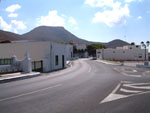
A
very picturesque town towards the south of the island, on the way to
Playa Blanca and Timanfaya if you're coming from the north of
theisland. Well worth stopping at, the main claim-to-fame of the town
is it was twice voted the most beautiful town in Spain. Along
theroadside and built into the sides of the mountaind are terraced
plots of land with palm trees and bouganvilla. There's a handful of
traditional restaurants and cafes. 'La Era', in particular, a
restaurant worth a visit.
|
La
Geria
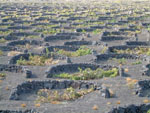
Certainly
worth a mention here, La Geria is the Lanzarote's main wine-growing
area. Although much of the island is covered in volcanic lava and rock,
"Picon" was also produced and this rock-like substance, broken into
small particles, has a unique property which absorbes moisture from the
air and pulls it down into the soil. Small semicirclular walls are
built to block the wind, picon is laid and the grape vines thive.
Lanzarote whites are better served at room temperature (according to
the locals), cooling removes their unique, aromatic properties. The
road going through this region - from Yaiza to San Bartolome - is well
surfaced but a little narrow in places and the surrounding landscape is
lava fields. So, slow gowing recommended.
|
|
|
|







